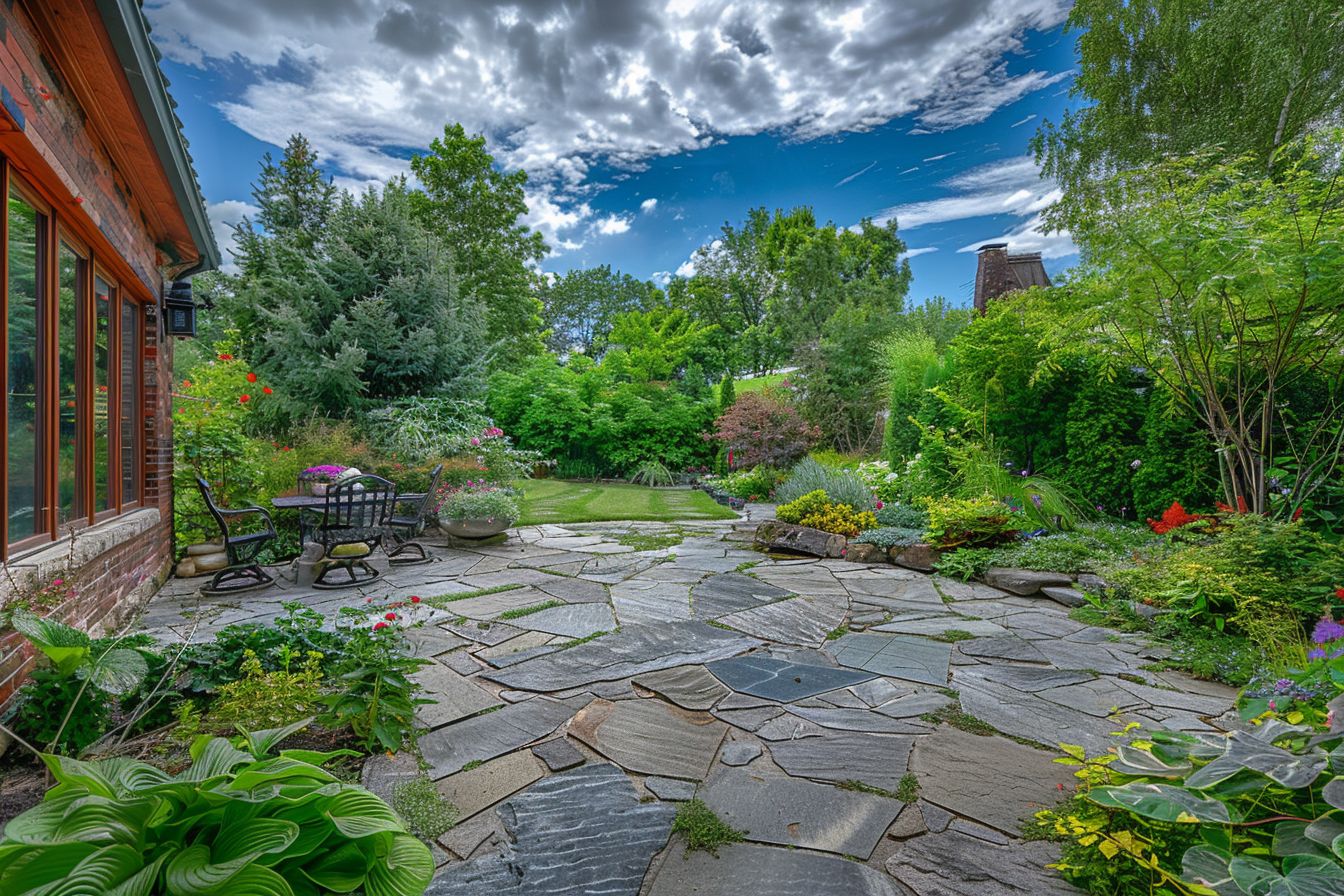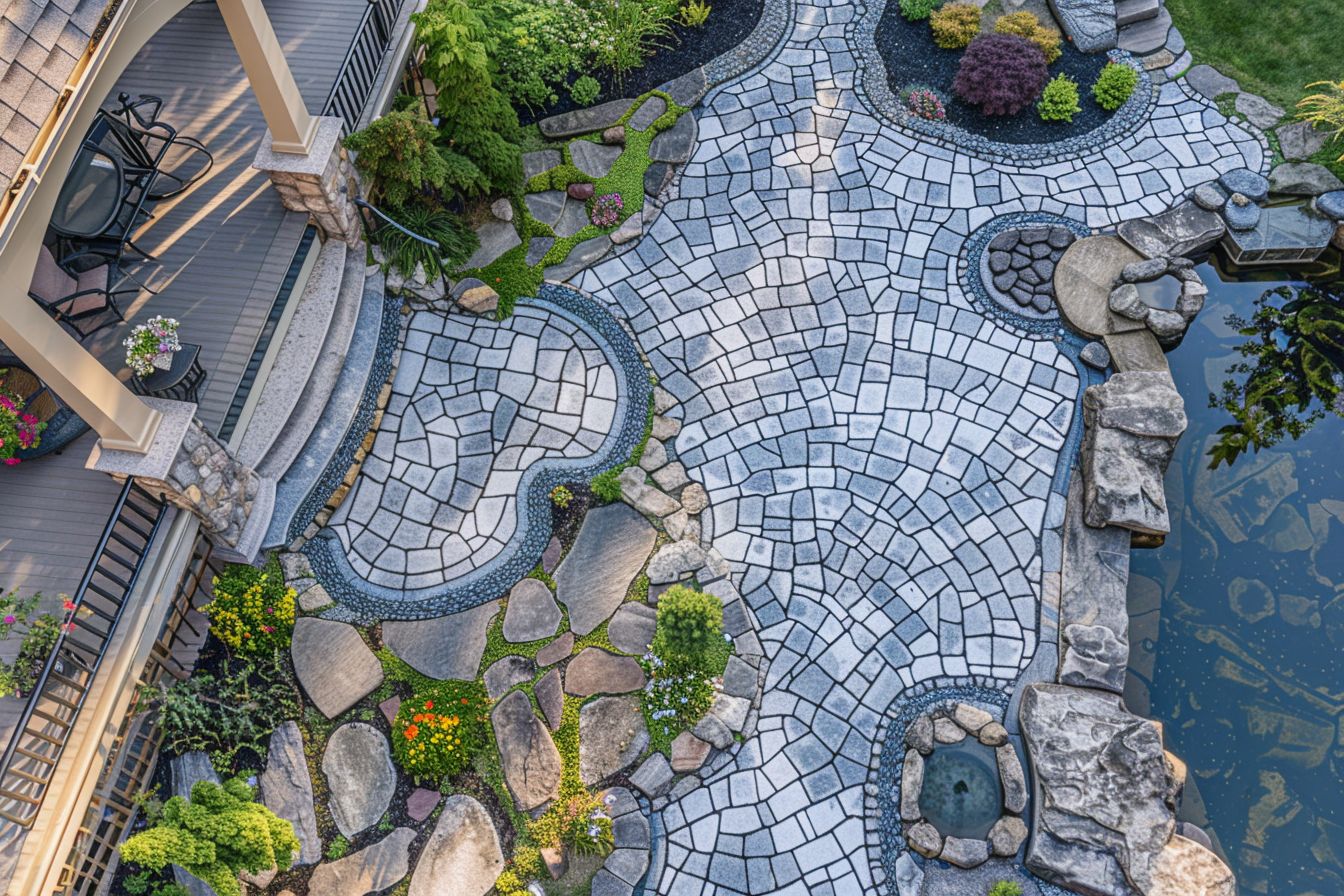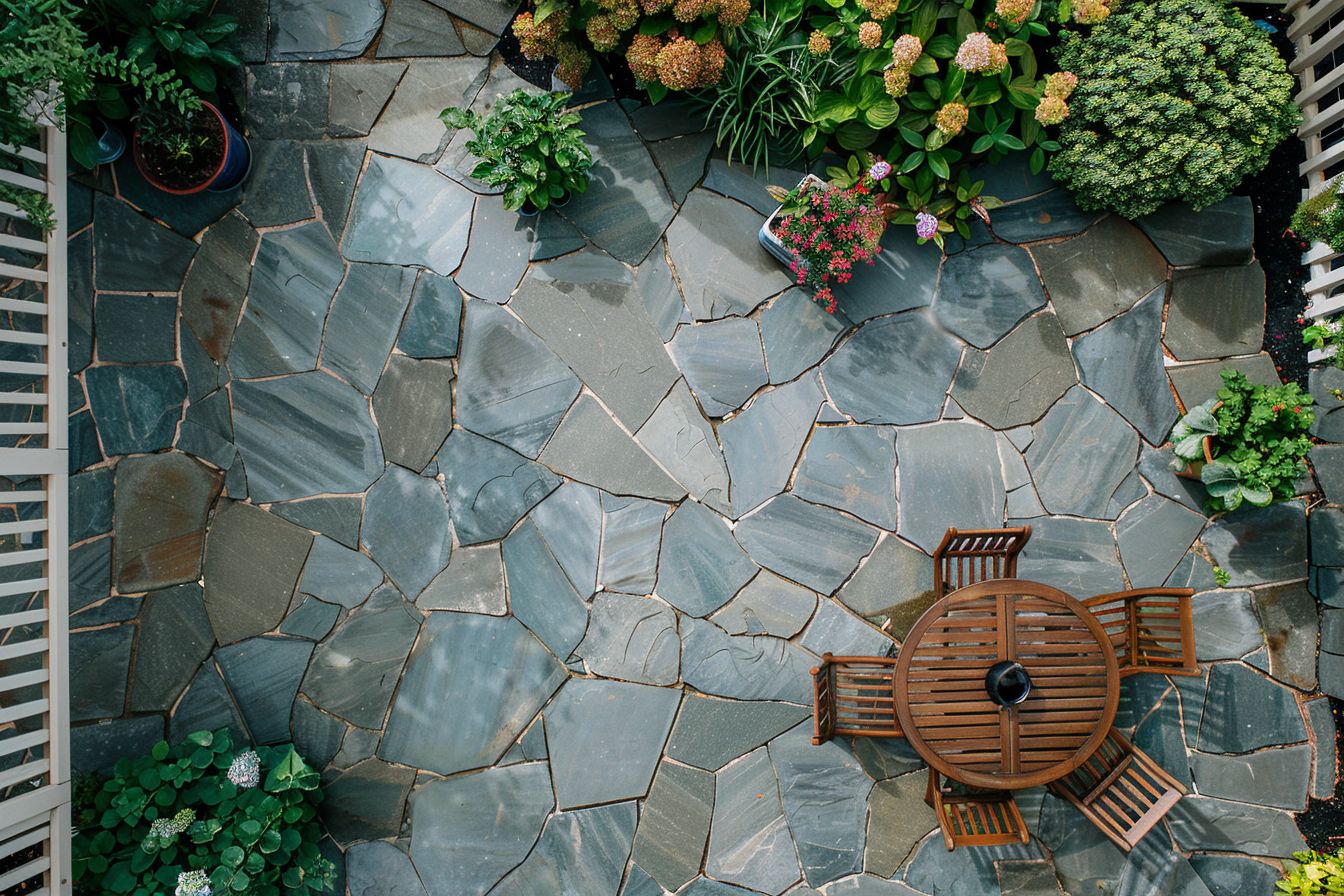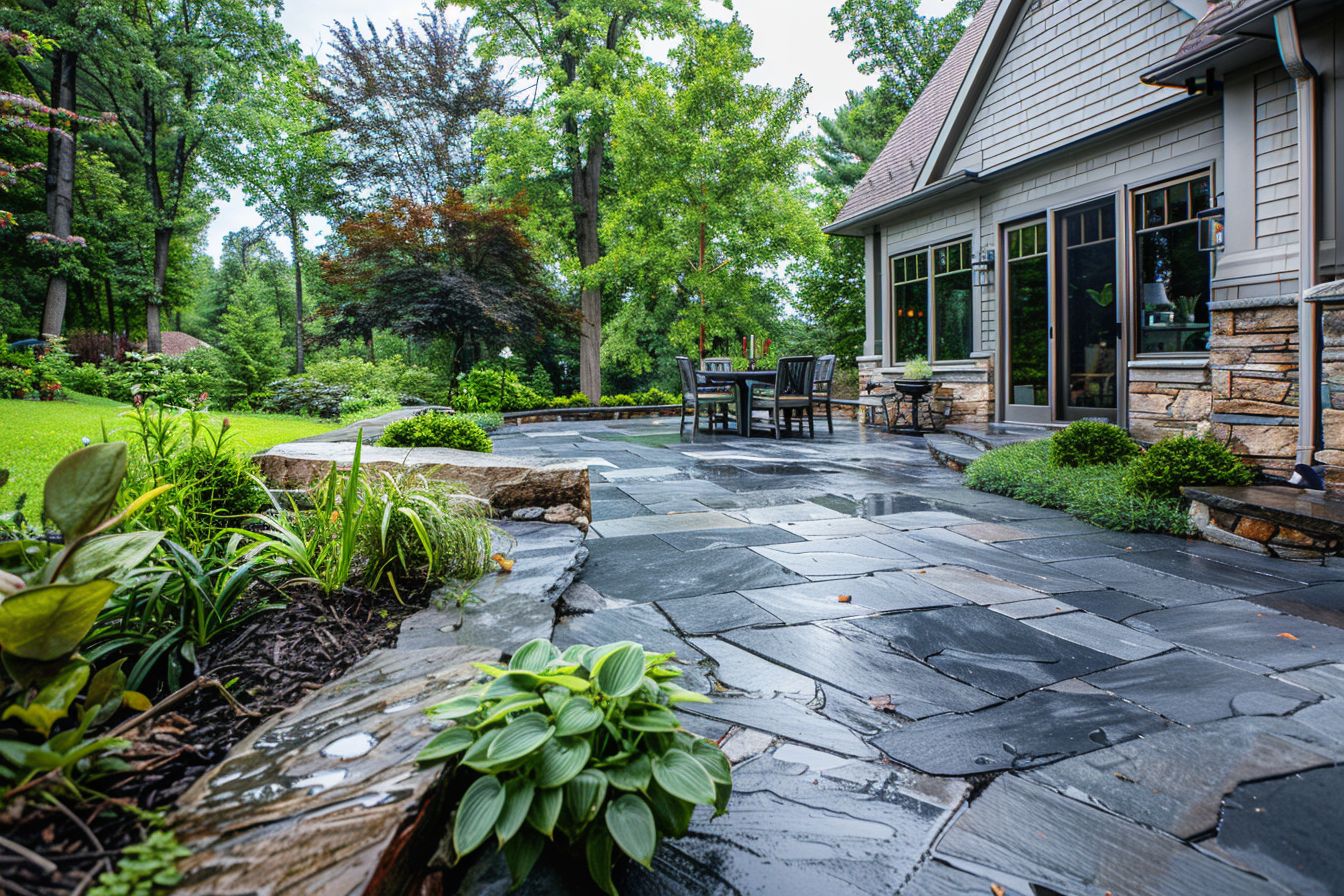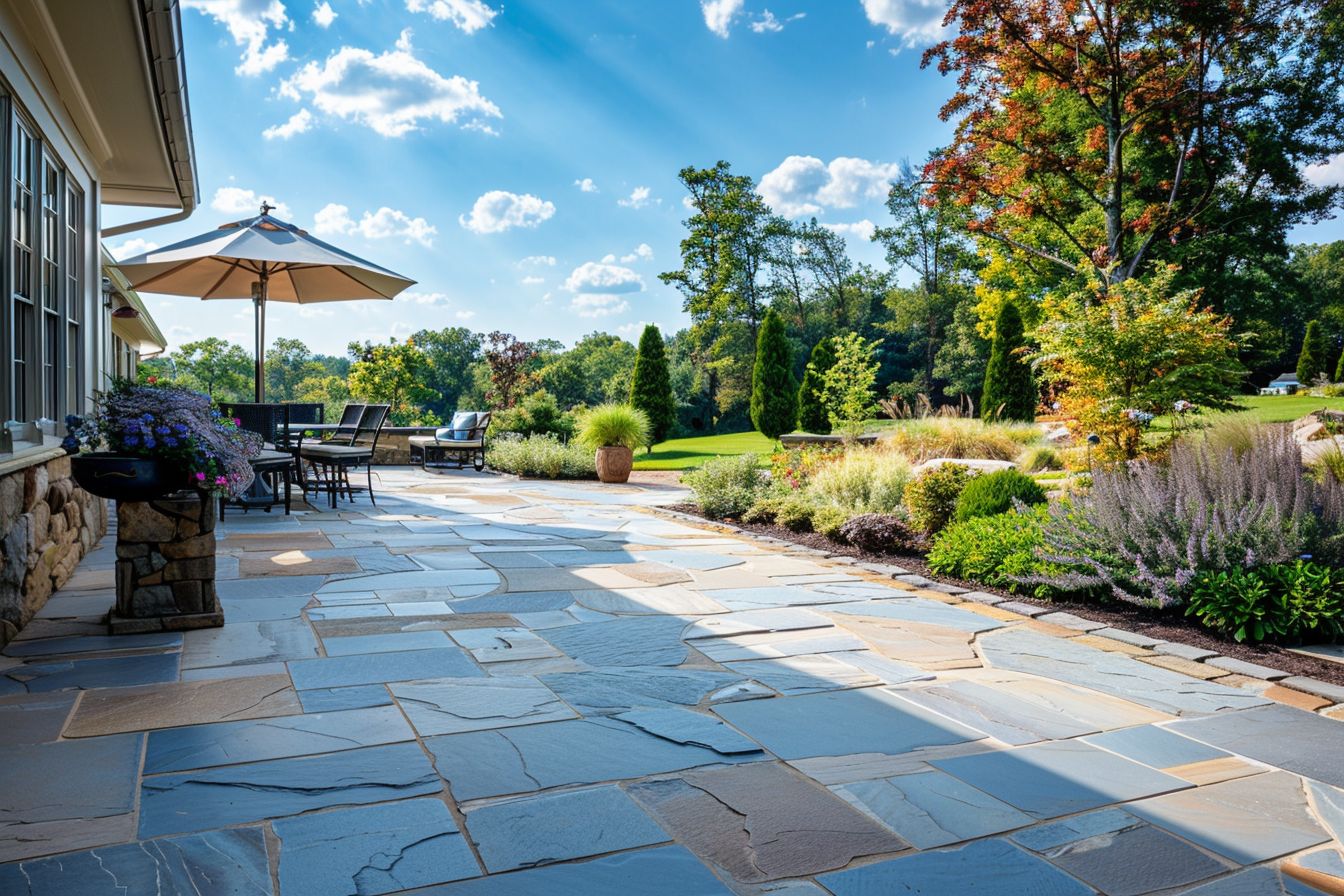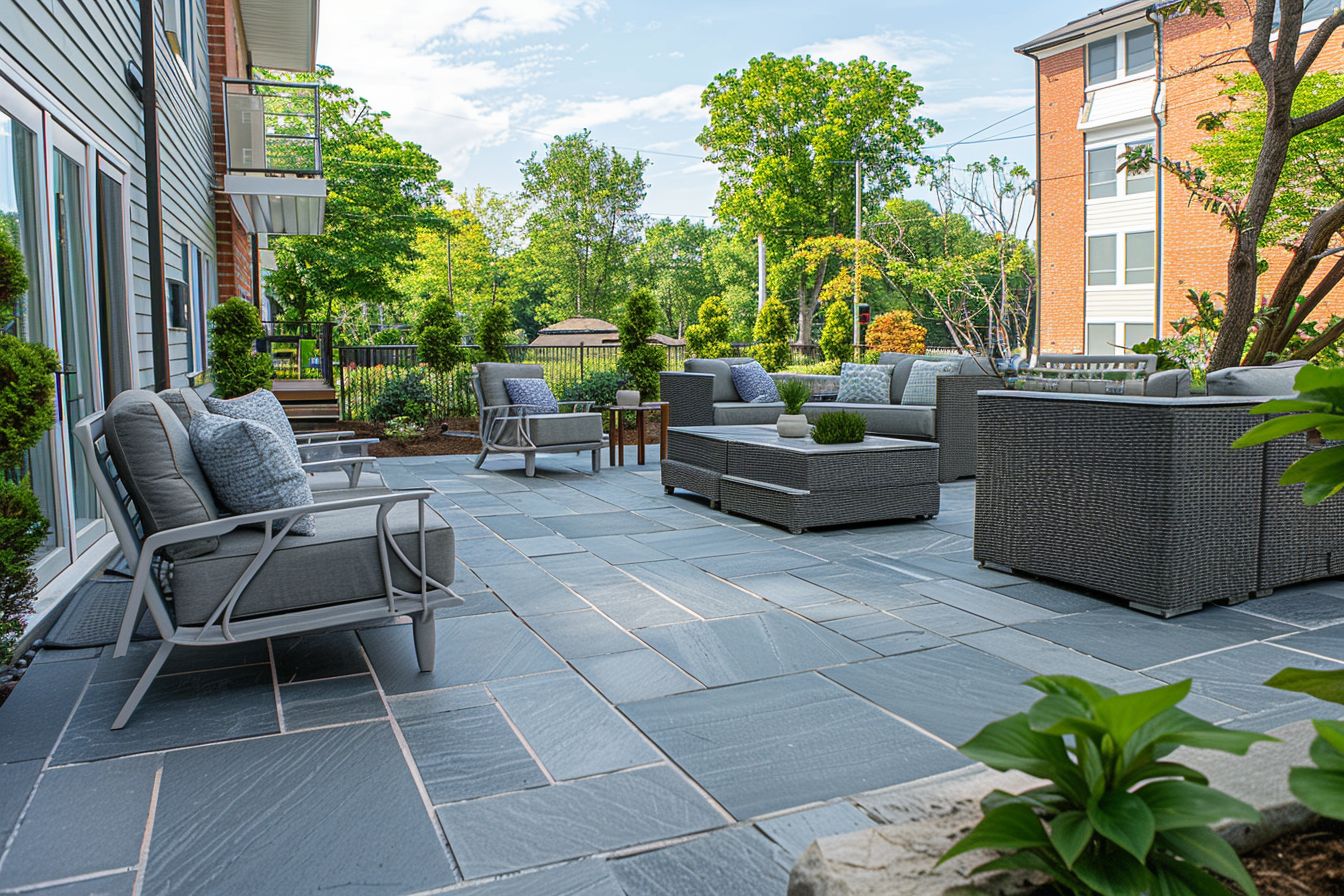Are you thinking about adding a bluestone patio to your backyard? You may have seen pictures online or at a friend’s house and loved the look. Getting the right Blue Stone Patio Ideas for your outdoor space is crucial, but with so many options, it can be overwhelming.
Blue stone, known for its durability and natural beauty, is a popular choice among homeowners.
Blue stone patios are unique because they come in various shapes, sizes, and colors. It means there’s something for every style and preference. Our guide will take you through everything from selecting the perfect type of blue stone to maintaining your patio through the seasons.
We’ll ensure you have all the information needed to create a stunning outdoor area that lasts for years.
Get ready to transform your backyard.
Understanding Blue stone for Your Patio
Bluestone is a durable, natural stone, perfect for outdoor patios. Its unique blue color and texture make it stand out from other patio materials.
What is Blue stone?
Blues tone is a durable and attractive natural stone made from sand and quartz. Its blue-gray hue adds elegance to any outdoor space. Because of its slip-resistant surface, people love it for patios, walkways, and around pools light.
One of the enduring qualities of blue stone is its ability to age gracefully. Over time, the blue color gently transitions to a more subtle gray, adding a touch of timelessness to any outdoor space. This unique characteristic makes blue stone a choice that will stand the test of time in your landscaping projects.
Available in various styles, such as natural cleft, thermal finished, and full color, blue stone is for every taste. Whether you choose patterned or irregular shapes, this stone elevates patio designs with its mix of hues.
My patio features irregular bluestone laid in a random pattern it has become the centerpiece of my backyard oasis.
How Blue stone Differs from Other Natural Stones
Bluestone stands out from other natural stones due to its unique color and durability. Unlike sandstone or limestone, which come in lighter shades, bluestone boasts a distinctive bluish-gray tone that adds a modern touch to any outdoor living area.
This stone is also known for being incredibly tough and able to withstand the test of time better than many alternatives. Its resistance to freeze-thaw cycles makes it ideal for patios in colder climates.
By choosing bluestone over materials like granite or marble, you’re not just getting a beautiful surface. You’re also ensuring the safety of your walkways and pool surrounds, even when wet, giving you and your loved ones peace of mind.
Thanks to its natural variation in texture and color range, each piece of bluestone has its own character. Whether used as larger slabs or cut into smaller tiles, it provides flexibility in design unmatched by most other stones.
Types of Bluestone for Your Patio (Natural Cleft, Full-Color, Select, Thermal Finished, Variegated, Pennsylvania & Regional, and Imported Alternatives)
Choosing the right type of bluestone for your patio can dramatically change its look and feel. Each variety of bluestones has unique characteristics that make your outdoor space stand out. Here’s a closer look at the options available.
- Natural Cleft Bluestone – This type comes with a slightly rough surface, giving it a more natural and rugged appearance. It’s perfect for adding texture to your patio while keeping that classic bluestone color range.
- Thermal Bluestone – Known for its smooth finish, thermal bluestone is heated to achieve a flat surface. It makes it ideal for a sleek, modern look in your backyard. I found its uniform texture not only pleasing but also practical for patio furniture placement.
- Variegated Bluestone – Variegated styles showcase an array of colors, including browns, golds, lavenders, and greens, providing a vibrant alternative to the traditional blue-gray stones. My neighbor chose this style, and it stunningly complements her colorful garden.
- Pennsylvania Bluestone – Extracted from the northeastern U.S., this dense, strong sandstone offers great stability for patios subject to heavy use. I’ve seen it hold up beautifully against all weather conditions in my cousin’s backyard.
- Full-Color Range Bluestone – Offering a mix of blues, grays, greens, and browns, this option brings a diverse palette to your design plans. Its variety can tie together different outdoor elements seamlessly.
- Select Blue – If you prefer a cooler tone with less variation, select blue focuses on those soothing blues and greys typical of bluestone but with more consistency in color.
- Thermal Finished Varieties – Apart from the regular thermal treatment mentioned earlier, there are special finishes some suppliers offer that add extra texture or patterns to the stone while keeping its surface flat.
- Imported Alternatives – While Pennsylvania bluestone is highly popular, imported alternatives from India or China provide similar aesthetics, often at a lower cost point, great if you’re redesigning on a budget.
From personal experience planning my own patio makeover to watching friends choose their ideal types of bluestone, I can say that these options allow homeowners to customize their outdoor spaces profoundly.
Designing Your Bluestone Patio
Creating a bluestone patio offers endless design options, from the layout to the finishing touches. You can pick interesting patterns and colors that match your home’s style.
Custom Cut Possibilities (Multi-Piece Random Patterns, Subway Tile Layouts, Herringbone Patterns, Circular Focal Points, Mixed Natural Material Integrations)
Custom-cut bluestone offers endless design options for your patio, turning your backyard into a stunning retreat. From organic shapes to modern designs, these custom cuts allow for creativity and flexibility.
Multi-Piece Random Patterns:
- These patterns use bluestone in various shapes and sizes for a natural look. Each piece fits together like a puzzle, creating an organic flow across your patio.
Subway Tile Layouts:
- Subway tile layouts arrange bluestone in staggered rows, similar to traditional subway tiles. This layout gives your patio a clean and orderly appearance with a touch of classic charm.
Herringbone Patterns:
- Herringbone patterns involve arranging rectangular stones in a zigzag fashion. This sophisticated design adds an eye-catching texture and depth to your patio space.
Circular Focal Points:
- Designing circular focal points involves cutting bluestone into precise arcs. These circles can center around features like fire pits or fountains, drawing the eye and adding interest.
Mixed Natural Material Integrations:
- Combining bluestone with other natural materials, such as wood, pebbles, or different types of stone—creates varied textures and colors. This integration enhances visual appeal and personalizes your space.
Each of these custom-cut possibilities brings its unique flair to your bluestone patio ideas, offering flexibility to align with your aesthetic goals. Whether you lean towards the random beauty of nature or prefer structured geometric patterns, there’s a custom-cut option that fits your vision perfectly.
Exploring Finish Options (Natural Cleft, Thermal Treatment, Flamed Texturing)
Bluestone patios offer unique finish options, each with its distinct look and feel. Homeowners can choose based on aesthetics, use, and maintenance levels.
Natural Cleft Finish
- The natural cleft finish shows bluestone in its raw beauty. This style comes from splitting the stone along its natural lines. It gives a rugged texture that blends well with outdoor settings. This finish is perfect for those who appreciate an organic look.
- Thermal Treatment
- Thermally treated bluestone has a smoother surface than natural cleft. Heat is applied to achieve a consistent and flat surface. Its uniform thickness makes it ideal for modern patio designs where sleekness is key.
- Flamed Texturing
Flamed texturing is not just about aesthetics; it’s a safety feature. This finish adds more grip to the stone’s surface, making it less slippery when wet, which is a reassuring choice for areas near pools or in rainy regions. The process involves exposing the stone to extreme heat and then rapid cooling, creating a slightly rough texture that enhances safety. These finishes impact not only your patio’s appearance but also its functionality and safety features. Such choices allow homeowners to customize their outdoor spaces uniquely suited to their lifestyle.
Now let’s look into installation tips for your chosen bluestone finish.
Color Palette Choices
Bluestone patios can shine in a full range of colors or stick to classic blue-blue shades, fitting any outdoor design theme you dream up. The stone’s natural variations bring out blues, grays, and even touches of green or purple, which are perfect for creating a unique backyard oasis.
Whether you’re planning a serene seating area for relaxation or an elegant dining space for entertaining, the versatile color ranges of bluestone patios can bring your vision to life. The adaptability of these materials is a key feature that can help you create the perfect outdoor space.
Installing Your Bluestone Patio
Installing your bluestone patio brings a fresh look to your outdoor space. Steps like laying the foundation and choosing the right materials guide you through the process. Read more to create a striking area perfect for relaxation and gatherings!
Installation Guide (Foundations, Base Materials, Cutting and Shaping, Laying Process, Drainage, Leveling, Grouting)
Getting a bluestone patio right needs planning and a bit of elbow grease. From my own experience, here’s a step-by-step guide to ensure your patio lasts for years.
- Foundation Work: Start by clearing the site. Remove any grass, roots, or debris, and make sure the area is flat. This step sets the stage for everything that follows.
- Base Materials: Lay a solid base using crushed stone or gravel. You’ll need several inches of this packing material spread evenly over the area. Compacting it well is key; it prevents settling later on.
- Cutting and Shaping Bluestone: Measure twice, cut once! Depending on your design – it may be rectangular or an elaborate herringbone pattern – you’ll need to cut stones to fit. Safety glasses and steady hands are must-haves here.
- Laying Process: Start placing bluestone on the compacted base material from one corner, working your way out. Use a rubber mallet to gently tap each piece into place, ensuring they’re level with each other.
- Ensure Proper Drainage: Slight sloping away from your home directs water runoff appropriately, preventing puddles on your new patio and potential damage to your property.
- Leveling Each Piece: As you lay each stone, check that it’s level with those around it. Small adjustments now prevent tripping hazards later.
- Grouting Joints: Once all stones are laid, fill the joints between them with stone dust or polymeric sand for a more polished look and weed prevention.
- Seasonal Care Tips: To maintain its beauty, clean your bluestone patio regularly and check for weeds or moss growth in joints.
By following these steps carefully and not rushing through the process, I installed my beautiful bluestone patio, which has become our favorite outdoor dining area. Regular maintenance ensures it remains a centerpiece in our backyard, where we enjoy countless meals and gatherings under the string lights.
Seasonal Care and Maintenance
Bluestone patios shine with a bit of care through the seasons. Reseal your stones every 1-2 years to keep them looking fresh and prevent damage. This task keeps water and stains from sinking in, especially after winter’s freeze-thaw cycles.
Power washing every few years removes dirt and grime, restoring the bluestone’s natural color without harsh chemicals.
In spring, check for any loose stones or signs of wear. Making quick repairs saves bigger headaches later. Remember, regular maintenance not only preserves your patio’s beauty but also its value.
Now, let’s move on to enhancing your space with unique features.
Enhancing Your Bluestone Patio Ideas
Give your bluestone patio a boost with smart upgrades and care tips that keep it looking great year-round.
Maximizing Potential (Local Insights, Seasonal Tips, Weed Control, Watering, Fire Pit Ideas, Retaining Walls, Hillside Landscaping)
A bluestone patio can transform your backyard into a stunning outdoor living area. With the right design and care, it becomes more than just a place to relax. It’s an extension of your home.
- Talk to neighbors or local experts about the best types of bluestone for your area. Different climates affect stone differently. I learned that our local Pennsylvania bluestone withstands our winters perfectly.
- Seasonal Tips
- Prepare your patio for winter by sealing it before the cold hits. In spring, check for any damage and clean the stones with mild soap and water.
- Weed Control
- Keep weeds at bay by filling gaps between stones with polymeric sand. It hardens and prevents weeds from poking through.
- Watering Your Patio
- Watering your patio can help settle the dust and keep it looking fresh. Just avoid doing so during freezing temperatures.
- Fire Pit Ideas
- Adding a fire pit to your bluestone patio creates a cozy gathering spot. Choose a style that complements the stone, such as my round, natural stone fire pit, which is always a hit with guests.
- Retaining Walls
- Build retaining walls that support sloped areas and also serve as seating around your patio or fire pit.
- Hillside Landscaping
- If your yard slopes, use it to your advantage by creating terraced sections with bluestone steps connecting each level.
From personal experience, integrating these elements can significantly enhance the function and appeal of your outdoor space, setting you up for years of enjoyment with family and friends.
Conclusion
Bluestone patios add timeless beauty and versatility to your outdoor space. They fit various shapes, sizes, and design tastes, from the elegance of natural cleft finishes to the sleek look of thermal treatments.
Simple installation methods like dry laying let you enjoy a stunning patio without much fuss. Maintenance is straightforward, ensuring your patio stays beautiful for years. Let these ideas inspire you to create an outdoor area you’ll love living in every day.
FAQs
1. What is bluestone, and why use it for a patio?
Bluestone is a type of natural, durable stone that comes from quarries. It’s perfect for patios because it lasts long, looks great with modern patio furniture, and can handle spills without getting ruined.
2. Can I make my old patio look new with bluestone?
Yes! By laying large pieces or various sizes of bluestone in a mosaic or random style, you can transform an old patio into something you’ll enjoy for years to come.
3. How do I choose the right design for my bluestone patio?
Think about your backyard space and design needs. Bluestone works well in different shapes, squares, rectangles, laid on the diagonal—or even a dry-laid flagstone pattern to match your outdoor furniture.
4. Is maintaining a bluestone patio hard work?
Not really, if sealed properly, bluestone resists water and stains. Just remember to clean up any spills quickly and refresh the sealant as needed.
5. What kind of furniture goes well with a bluestone patio?
Natural materials like wicker or wood complement bluestone’s earthy tones best. Choose outdoor furniture that fits your backyard’s vibe, cozy around the fireplace or sleek for entertaining.
6. Are there creative ways to lay out my bluestone pavers?
Absolutely! Try laying them parallel or perpendicular to create interest; mix different sizes for texture; or add pea gravel between stones for contrast, all these ideas will make your backyard stand out.

Jonathan Fleck, a seasoned 40-year-old writer and editor, boasts an impressive 12-year career specializing in the dynamic realms of Home and Garden. As the Chief Editor of Home and Around Blog, Jonathan is at the forefront of curating content that resonates with enthusiasts and novices alike. His vast knowledge encompasses a range of topics, including houseplants, small space gardening, home DIY, small space living, and crafting.
Jonathan’s academic journey includes a graduation with a degree in the History of Art from Long Island University (LIU) in New York City, New York, United States. This educational background, coupled with his passion for creative expression, has shaped his unique approach to writing about the aesthetics and functionality of living spaces.
With a keen eye for detail and a wealth of experience, Jonathan has become a trusted voice in the Home and Garden community. His articles not only provide practical advice but also inspire readers to transform their living environments into personalized havens. Whether it’s cultivating a thriving indoor garden, optimizing small living spaces, or embarking on creative DIY projects, Jonathan Fleck’s expertise shines through, making him a respected authority in the field.


